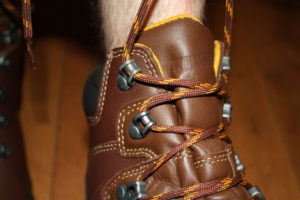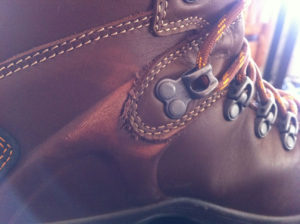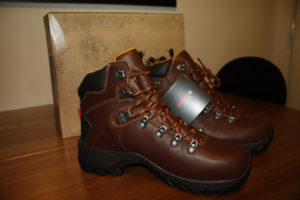 I’d never worn a pair of Wolverine boots before – but when the company offered to send me a pair to check out their new “Individual Comfort System,” I figured I’d lace them up and take them on a test hike to see if the extra bells and whistles made a difference on the trail.
I’d never worn a pair of Wolverine boots before – but when the company offered to send me a pair to check out their new “Individual Comfort System,” I figured I’d lace them up and take them on a test hike to see if the extra bells and whistles made a difference on the trail.
Wolverine’s Individual Comfort System or ICS consists of an adjustable disc that rests in the heel of each boot. The disc can be turned by the user to provide a more firm or cushioned heel-strike, as well as slight compensation for those of us who roll our feet inward or outward when we’re hiking. Each disc is labeled for the left or right boot, so if you have an uneven stride or only roll one of your feet, you can still hike comfortably.
The disc itself is just this little rubber piece – you can see the labels for Cushion and Firm – the I is for inward support for those with low arches or ‘flat feet’ and the O is for outward support for those who have under-pronation in their walk. The disc slides easily into the heel of each boot beneath the insole, and is very easy to use.
I tried out all of the different settings on a short walk just to get a feel for them. While I could definitely feel the difference between the Cushion and Firm settings (the Cushion is REALLY soft, while the Firm provides a bit more ‘spring’ in your step), the Inward and Outward settings were a bit less pronounced. I could definitely feel a difference in the way my foot was striking and the inserts were encouraging my feet to go in their advertised direction, but I think this would best be used for only very mild instances of inward or outward foot rotation. If you’re really noticing it affecting your walking or hiking, you’d be better off with a more aggressive change to your boot, like a SuperFeet insole.
Construction wise, the boots themselves are extremely solid. The Fulcrum features a full-grain leather upper and very tough (and slightly height-enhancing) Vibram Mutant outsole, along with a Gore-Tex liner. I took these boots up Icehouse Canyon and my feet kept dry and warm through a few splashy areas. In addition, the high ankles and ample lace loops ensure these boots are going to stay in place on your feet.
While the boots themselves were strong and held up structurally to standard trail abuse, aesthetically they did not. Even on a short urban hike through Echo Park, the leather outsoles got noticeably scuffed, both on the front and side of the boots.
Now, chances are you probably don’t care what your hiking boots look like after a few hours on the trail. I usually clean my boots when I get home but don’t stress out about it too much – after all, you are trying to get them dirty. So, this is a very minor complaint about the boots themselves, as long as it’s not indicative of how the leather holds up in the long term.
Overall, I liked these boots although I’m not entirely sold on the Individual Comfort System quite yet. Maybe my foot rotation wasn’t pronounced enough to notice a difference with the disc adjustment, but these boots are on the expensive end of the price range for similar brands – the Fulcrum retails at $200. If having an adjustable heel is something you think you’d dig, then you should definitely give these guys a test run in a store. They’re built well (scuffs notwithstanding) and were very comfy to wear on a cold weather hike … but in my opinion, I think your cash and time might be better spent finding a fine-fitting, cheaper boot and swapping out insoles to correct for rolling if you have it.
Tags: boots, fulcrum, hiking boots, ics, individual comfort system, product review, Review, wolverine






